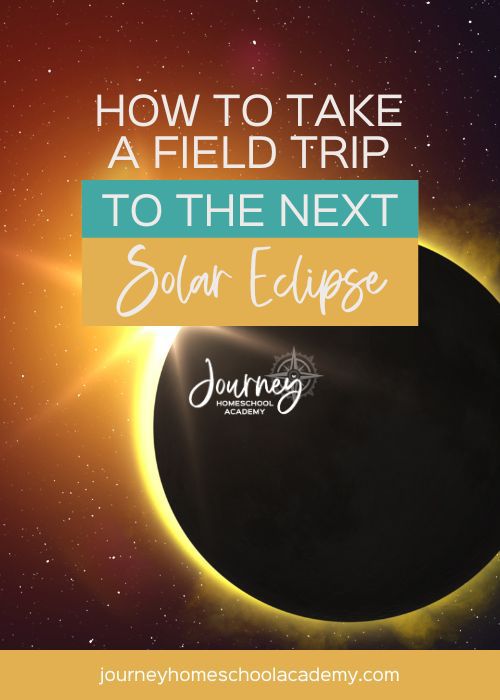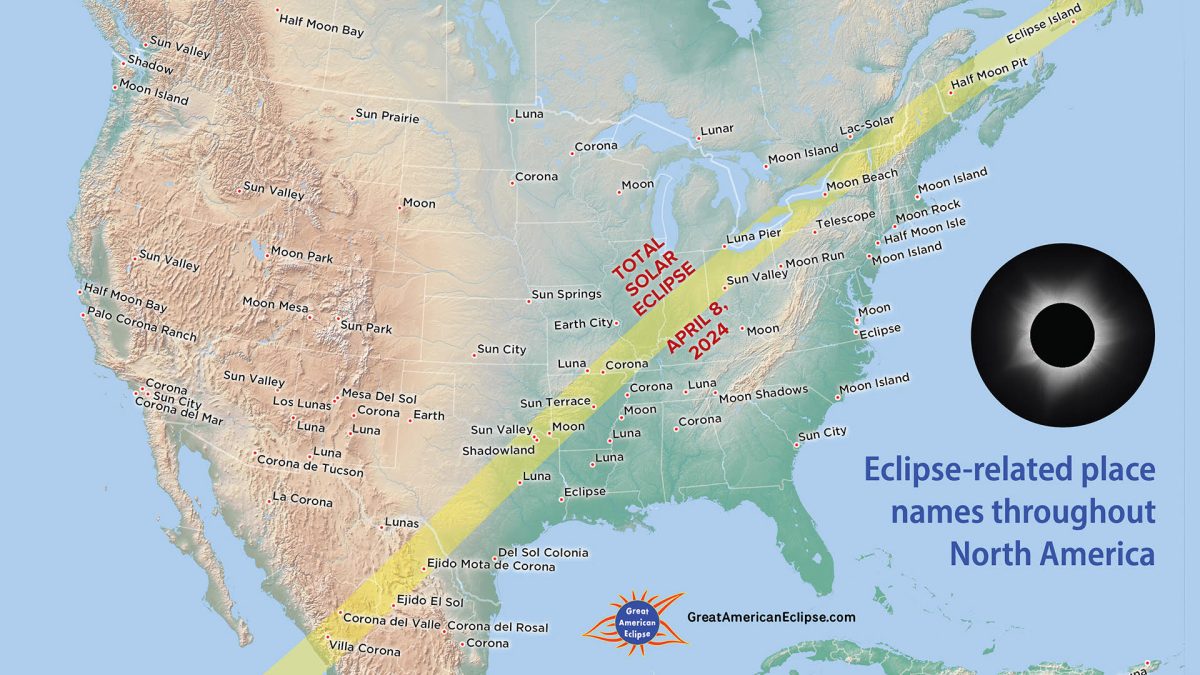On Monday, April 8, 2024, millions of people in the United States will experience a unique event: a total eclipse of the sun.
Below is a guide for planning a field trip to see the next solar eclipse. It’s a rare event you won’t want to miss!

What is a Total Solar Eclipse?
A solar eclipse is an event where Earth’s moon temporarily blocks the light of the sun.
Eclipses can be partial (the moon covers part of the disk of the sun in the sky), annular (the moon completely enters the disk of the sun but isn’t large enough to completely obscure it), or total (the moon completely covers the sun).
Why Travel to the Next Solar Eclipse?
Perhaps it seems silly to travel somewhere to watch a total solar eclipse, but those who have witnessed these events can testify to how fascinating they are to see.
In the moments before the moon completely covers the sun—what is called “totality“—the world around you will begin to change.
- Shadows might start to take on an odd appearance as the crescent shape of the sun above gets smaller and smaller.
- Just before totality, you may notice the temperature begin to drop.
- Wildlife might also start to act strange right before totality because the animals don’t know what’s going on. They mistake it for the beginning of evening. Many species of birds will become very quiet as if it is night time. Some animals start move toward their sleeping areas. Some spiders will begin dismantling their webs. More intelligent animals like chimpanzees will actually point at the sun noticing the eclipse.
Finally, at totality, the sky will grow very dark—dark enough to see stars and planets. As you look up at the sun, you’ll be able to see the corona of the sun, the hot atmosphere of the sun that is usually completely blocked from view.
Many people on Earth have seen partial solar eclipses, when the moon partially covers the sun’s light. But total solar eclipses—when the moon completely covers the disc of the sun—occur once every 17.6 months and are only visible from less than half a percent of the Earth’s surface. The darkest part of the shadow (called the umbra), at best, is only 166 miles across.
This means, from a specific location, a total solar eclipse only shows up once every 360 years, on average.
What’s So Special About the Great North American Eclipse?
The eclipse occurring on April 8, 2024, will sweep through the center of Mexico and across the United States, starting in south Texas, and fly over the eastern portion of the United States.
The next total solar eclipse visible in the United States won’t take place for another 28 years, in 2052, so unless you’re prepared to travel outside North America, you’ll need to wait nearly three decades to see another one.
Where Do You Travel to See the Eclipse?

(Image courtesy of Michael Zeiler, GreatAmericanEclipse.com)
The yellow line shows the path of totality. Locations north or south of this line, viewers will likely see a partial eclipse, but only in the yellow path will viewers be under the “umbra” of the moon’s shadow—the part where all sunlight is blocked.
The #1 goal is to get into the “path of totality.” When it comes to seeing a total eclipse, “close” is not close enough. You’ll want to be directly in that path, because outside of that path, the sun will only be partially covered.
Where you go to see the eclipse will be based on a number of factors:
- Where you live – Obviously, if you happen to live in or close to the path of totality, and you don’t want to travel far, you could just go to the closest place on the map in the path.
- Weather predictions – Keep an eye on the weather forecasts. Choose your preferred location in advance, but have backup locations in mind if weather doesn’t look promising. There’s more information about weather below.
- Access to highways – Considering you may need to change your planned location due to weather, finding locations in the path of totality close to highways will be important if you need to make a last-minute change.
- Social events – You may want to find somewhere remote to see the eclipse, but many people would prefer to go an “eclipse party” somewhere. All along the path of totality there are formal events set up my amateur astronomy associations and other organizations.
What Time is the Eclipse?
As the moon’s shadow zooms across the face of the earth, different regions will see the total eclipse as different times. Below are when some major cities will see it.
Dallas, Texas – 1:40-1:44pm CDT
Little Rock, Arkansas – 1:51-1:54pm CDT
Paducah, Kentucky – 2:00-2:02pm CDT
Evansville, Indiana – 2:02-2:05pm CDT
Cleveland, Ohio – 3:13-3:17pm EDT
Buffalo, New York – 3:18-3:22pm EDT
Lancaster, New Hampshire – 3:27-3:30pm EDT
To find more specific times for the area you may travel, go to TimeAndDate.com to interact with their eclipse map.

Where Will Weather Be the Best?
Obviously, no one can accurately predict weather months in advance, but weather experts have compiled satellite data for early April along the path of totality.
The best chances for cloudless skies in the US will be south of Missouri, in states like Arkansas and Texas. States like Illinois, Indiana, Ohio, and New York have historically seen much more cloud clover in early April. However, Mexico has historically seen much clearer skies than the US.
Starting the week before the eclipse, there will be more reliable forecasts, which will enable people to choose a precise location.
For a list of some of the best locations to see the next solar eclipse, based on previous year’s weather data, go to eclipsophile.com.
What Do You Need to Bring?
An absolute MUST are eclipse glasses for everyone in your party. You should NEVER stare at the sun without using approved filter material designed expressly for solar viewing.
The ONLY TIME you can view the eclipse directly without these special glasses is during totality, when the disc of the sun is completely covered by the moon.
Be sure to bring hats, sunscreen, umbrellas—anything to prepare you for the weather in your area.
Bring your own entertainment and food. You’ll want to set up camp somewhere well before the eclipse starts.
What Do You Do the Day of the Next Solar Eclipse?
Depending on your location, the moon will begin to eclipse the sun between 70 and 90 minutes before totality. This is the slow build-up to darkness. After totality, the moon will slowly leave the disc of the sun, taking about the same amount of time.
Keeping in mind the time of totality at your chosen location, and the fact that there may be many pilgrims traveling near you, you will want to set up camp plenty of time before the moon begins to cover the sun.
Make sure everyone has their glasses on.
At the moment of totality, everyone can remove their glasses. There is only a small window of time, so take advantage of every second. Look up to see if you can observe any stars, constellations, or planets. Looking out at the horizon, you’ll be able to see what looks like a sunset glow because miles away the sunlight is hitting the ground all around you.
FREE Lesson on Eclipses!
From now until the day of the eclipse, you can see our video lesson about solar eclipses from the Experience Astronomy course for free! This is exclusive content, usually only for those who are registered for the course, but from now until April 8, you’ll be able to watch it with your kids!
